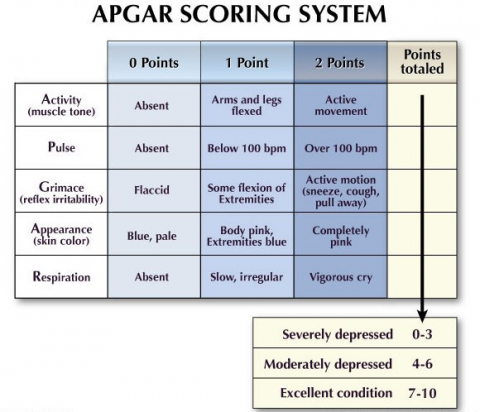Congratulations, new parent! Your little bundle of joy has arrived, and we know you want to ensure their well-being every step of the way. That’s why understanding the Apgar Score is so important. This simple yet crucial assessment is performed on your newborn baby to evaluate their overall health immediately after birth.

Image Source: http://www.emsworld.com/sites/default/files/styles/large/public/files/base/image/EMSR/2012/01/apgar_10616033.png?itok=4wph6xaC
What is the Apgar Score?
It assesses your baby’s physical abilities and determines if further medical care or guidance is needed. The score also helps identify potential issues in your baby’s maturity, ensuring a smooth transition into their new life.
But what exactly does it measure?
The Apgar Score is conducted twice – one minute and five minutes after birth – giving an in-depth understanding of your baby’s condition. By examining factors like muscle tone, reflexes, heart rate, irritability, appearance, and respiration, this test provides healthcare professionals with essential insights into your baby’s overall health and maturity.
Rest assured, it’s a simple and harmless examination that requires no special preparation or intervention from parents. The test is typically carried out by healthcare professionals specializing in newborn care, ensuring accurate evaluation and interpretation of the results.
5 Elements in Measuring Apgar Score
During the Apgar Score assessment, five critical factors are used to evaluate your baby’s physical abilities and determine if further medical care or guidance is needed. So, let’s dive into each element of this fascinating evaluation!
1. Muscle Tone (Activity): By observing the baby’s arm and leg movements, they can assess their overall muscle strength and coordination. This gives them an insight into their readiness for independent exploration.
2. Reflexes (Grasp): They gently place a finger in your baby’s tiny hand to test their instinctive grasp reflex. This natural response indicates healthy neurological function—a great sign for their development.
3. Baby’s Heart Rate (Pulse): A strong heartbeat above 100 beats per minute ensures proper oxygenation throughout the body. It’s a reassuring indicator of good cardiovascular health.
4. Irritability (Grimace): They observe how your baby responds to mild stimuli through gentle taps on their feet or nose. Their reactions help us gauge their level of responsiveness—an essential aspect of their maturity.
5. Appearance (Skin Color) and Respiration (Breathing): They examine both appearance and respiration together because they go hand in hand. Your baby should have a healthy pinkish hue, indicating good blood circulation and oxygen levels within seconds after birth.
Additionally, healthcare professionals listen for those precious first cries, which give them insights into the baby’s breathing pattern and potential respiratory issues.
Why is the Apgar Score necessary and crucial?
Well, it allows healthcare professionals to quickly determine if there are any immediate risks to your baby’s life. If the score falls below 5, it signals a need for further medical attention. And here’s the best part: this simple assessment is not only cost-effective but can potentially save lives.
The Apgar Score is widely accepted as the primary newborn assessment tool, embraced by maternity care providers worldwide. It is vital to ensure your little one transitions smoothly into their new environment and uncovers any signs of underlying health problems at the earliest stage possible.
So, embrace this valuable assessment, knowing that it has been designed with utmost care to safeguard your baby’s well-being right from their very first moments of life. As parents, being informed about every aspect of your baby’s health empowers you to make educated decisions and provide them with the best possible care.
Written by:
Tina I Ureten MD, RDMS, RDCS





 Invitez familles et amis à assister à cet événement mémorable de votre grossesse. Célébrez avec vos proches où qu’ils soient dans le monde ce moment spécial de lien avec l’enfant.
Invitez familles et amis à assister à cet événement mémorable de votre grossesse. Célébrez avec vos proches où qu’ils soient dans le monde ce moment spécial de lien avec l’enfant. Rien n’est plus beau que les battements de cœur de votre bébé. Enregistrez ce son pour toujours dans un Ourson Coup de cœur de UC Baby®. Il ne s’agit pas simplement d’un beau souvenir, mais aussi d’un moyen efficace qui apaise votre bébé pour l’aider à s’endormir.
Rien n’est plus beau que les battements de cœur de votre bébé. Enregistrez ce son pour toujours dans un Ourson Coup de cœur de UC Baby®. Il ne s’agit pas simplement d’un beau souvenir, mais aussi d’un moyen efficace qui apaise votre bébé pour l’aider à s’endormir.

